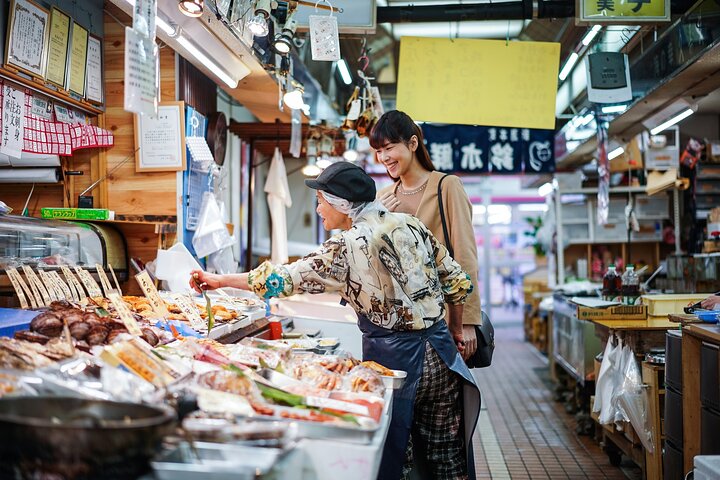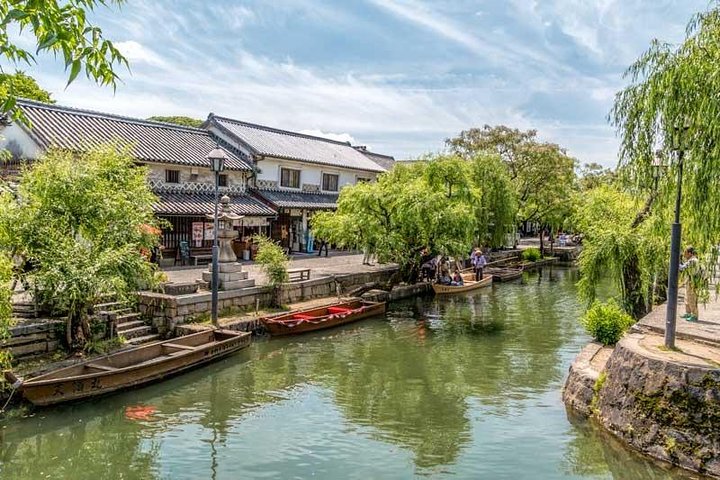Maximize your last day in Tokyo with a private 7-hour tour and Narita airport drop-off. Customize your itinerary and explore with ease.
Maximize your last day in Tokyo with a private 7-hour tour and Narita airport drop-off. Customize your itinerary and explore with ease.
- Tokyo - The guide will greet you at your designated meeting point within one of Tokyo’s 23 wards.
-
Imperial Palace - This tour does not include entry to the interior of the Imperial Palace
The current Imperial Palace is situated on the former site of Edo Castle, featuring a vast park area encircled by moats and impressive stone walls in…
-
Tokyo - The guide will greet you at your designated meeting point within one of Tokyo’s 23 wards.
-
Imperial Palace - This tour does not include entry to the interior of the Imperial Palace
The current Imperial Palace is situated on the former site of Edo Castle, featuring a vast park area encircled by moats and impressive stone walls in central Tokyo, just a short walk from Tokyo Station. It serves as the residence of Japan’s Imperial Family. The palace’s inner grounds are typically not accessible to the public. -
The East Gardens of the Imperial Palace (Edo Castle Ruin) - Discover numerous historical relics and experience the ambiance of the Edo Period amidst beautiful natural surroundings. Travel back 400 years to the era of the Shogun right in the heart of Tokyo!
-
Asakusa - Sensoji Temple and Nakamise Shopping Street are among Tokyo’s most popular attractions! Delight in local treats and learn about Buddhism in Japan at this temple. The atmosphere is quintessentially retro Japan!
-
Tsukishima Monjya Street - Savor a taste that is uniquely Tokyo at one of the many Monjya restaurants here!
-
Tsukiji Fish Market - Discover the old fish market in Tokyo! Experience local dishes and enjoy fresh seafood!
-
Hama Rikyu Gardens - Hama Rikyu (浜離宮, Hama Rikyū) is a large, picturesque landscape garden in central Tokyo. Situated alongside Tokyo Bay, Hama Rikyu features seawater ponds that change with the tides, and a teahouse on an island where visitors can relax and enjoy the view. The traditional garden contrasts sharply with the skyscrapers of the nearby Shiodome district.
-
Kappabashi Street (Kappabashi Dogugai) - Explore this shopping district known for its uniquely Japanese cooking utensils and plastic food model displays. Pick up a miniature food model keychain as a memento of your trip to Japan!
-
Meiji Jingu Shrine - Meiji Shrine (明治神宮, Meiji Jingū) is dedicated to the deified spirits of Emperor Meiji and his consort, Empress Shoken. Located next to the JR Yamanote Line’s bustling Harajuku Station, Meiji Shrine and the adjacent Yoyogi Park form a large forested area within the densely built city. The spacious shrine grounds offer walking paths perfect for a leisurely stroll.
The shrine was completed and dedicated to Emperor Meiji and Empress Shoken in 1920, eight years after the emperor’s passing and six years after the empress’s passing. The shrine was destroyed during World War II but was rebuilt shortly thereafter.
- Takeshita Street - Harajuku (原宿) refers to the area around Tokyo’s Harajuku Station, located between Shinjuku and Shibuya on the Yamanote Line. It is the hub of Japan’s most extreme teenage cultures and fashion styles, but also offers shopping for adults and some historical sights.
The heart of Harajuku’s teenage culture is Takeshita Dori (Takeshita Street) and its side streets, lined with trendy shops, fashion boutiques, used clothing stores, crepe stands, and fast food outlets catering to fashion-conscious teens.
- Shibuya Crossing - Visit the famous and bustling Shibuya scramble crossing to witness one of Tokyo’s busiest areas!
- Shinjuku Gyoen National Garden - Shinjuku Gyoen was built on the site of a private mansion belonging to a “daimyo” (feudal lord) Naito, during the Edo era (1591). A government-managed agricultural experiment station was established in 1872, and later it became an imperial estate, completed in 1906 as an imperial garden. It evolved as a palace garden for international diplomacy, re-designated as a national garden after World War II and opened to the public.
- Koishikawa Korakuen Garden - Koishikawa Korakuen (小石川後楽園, Koishikawa Kōrakuen) is one of Tokyo’s oldest and finest Japanese gardens. It was constructed in the early Edo Period (1600-1867) at the Tokyo residence of the Mito branch of the ruling Tokugawa family. Like its namesake in Okayama, the garden was named Korakuen after a poem encouraging a ruler to enjoy pleasure only after ensuring happiness for his people. Koishikawa is the district where the garden is located.
- Ginza - If you appreciate high-quality brands and shopping, Ginza is a must-visit! Enjoy shopping at various high-end department stores or pick up some pearls for someone special at Mikimoto.
- Yanaka Ginza Shopping Street - A beautifully retro shopping street with plenty of charming stray cats. Stop by to enjoy some famous croquettes!
- Akihabara - Akihabara (秋葉原), also known as Akiba after a former local shrine, is a district in central Tokyo renowned for its numerous electronics shops. In recent years, Akihabara has gained fame as the center of Japan’s otaku (diehard fan) culture, with many shops and establishments dedicated to anime and manga now interspersed among the electronic stores in the district. On Sundays, Chuo Dori, the main street through the district, is closed to car traffic from 13:00 to 18:00 (until 17:00 from October through March).
- Tokyo National Museum - The Tokyo National Museum (東京国立博物館, Tōkyō Kokuritsu Hakubutsukan) is the oldest and largest of Japan’s top-level national museums, which also include the Kyoto National Museum, the Nara National Museum, and the Kyushu National Museum. It was initially established in 1972 at Yushima Seido Shrine and moved to its current location in Ueno Park a few years later.
The Tokyo National Museum boasts one of the largest and finest collections of art and archaeological artifacts in Japan, comprising over 110,000 individual items, including nearly a hundred national treasures. At any given time, about 4000 different items from the permanent museum collection are on display. Additionally, temporary exhibitions are held regularly. Excellent English information and audio guides are available.
- Rikugien Garden - Rikugien (六義園) is often regarded as Tokyo’s most beautiful Japanese landscape garden alongside Koishikawa Korakuen. Built around 1700 for the 5th Tokugawa Shogun, Rikugien literally means “six poems garden” and recreates in miniature 88 scenes from famous poems. The garden is a prime example of an Edo Period strolling garden and features a large central pond surrounded by manmade hills and forested areas, all connected by a network of trails.
- Odaiba District - Odaiba (お台場) is a popular shopping and entertainment district on a man-made island in Tokyo Bay. It originated as a set of small man-made fort islands (daiba literally means “fort”), constructed towards the end of the Edo Period (1603-1868) to protect Tokyo against potential sea attacks, specifically in response to the gunboat diplomacy of Commodore Perry.
More than a century later, the small islands were merged into larger islands through massive landfills, and Tokyo embarked on a spectacular development project aimed at transforming the islands into a futuristic residential and business district during the extravagant 1980s. However, development was significantly slowed after the “bubble economy” burst in the early 1990s, leaving Odaiba nearly vacant.
- Shibamata - Shibamata (柴又) is a neighborhood on the eastern edge of Tokyo, not far from the Edogawa River, which serves as the natural border between Tokyo and Chiba Prefecture. The town retains its old-school charm from days gone by and offers a perfect escape from modern Tokyo. One of the main attractions is the Shibamata Taishakuten Temple, located not far from the station.
- Nezu Shrine - Having miraculously avoided major damage during world wars and natural disasters, Yanaka and Nezu—two of the neighborhoods that make up shitamachi, Tokyo’s old downtown—retain their last-century charm. You’ll find historical sites such as Yanaka Cemetery and Nezu Shrine tucked away among shitamachi’s narrow back alleys, traditional wooden houses, izakaya pubs, atmospheric coffee shops, and retro stores selling old-style sweets and snacks. Here, you can step back in time to a slower-paced, more genteel Tokyo.
- Narita International Airport Terminal 1 Travel Center - After the tour, you will be taken to Narita Airport for a relaxing journey to the airport. Please note that travel time to Narita is included in your tour time.

- Private vehicle
- Customizable Tour of your choice of 3-4 sites from ‘What to expect’ list
- Licensed Local English Speaking Guide
- Pick up in Tokyo and Drop off at Narita airport
- Private vehicle
- Customizable Tour of your choice of 3-4 sites from ‘What to expect’ list
- Licensed Local English Speaking Guide
- Pick up in Tokyo and Drop off at Narita airport
- Entrance fees, Lunch, and Other personal expenses
- You cannot combine multiple tour groups.
- Guide Entry fees are only covered for sights listed under ‘What to Expect.’
- Entrance fees, Lunch, and Other personal expenses
- You cannot combine multiple tour groups.
- Guide Entry fees are only covered for sights listed under ‘What to Expect.’
This is the ideal tour for travelers who are leaving Japan from Narita airport! You can get in a private vehicle with your heavy luggage and continue your Tokyo sightseeing until the last minutes of your stay!
Tokyo is where you can experience both modern and traditional, and your experienced private English-speaking and licensed guide will help you…
This is the ideal tour for travelers who are leaving Japan from Narita airport! You can get in a private vehicle with your heavy luggage and continue your Tokyo sightseeing until the last minutes of your stay!
Tokyo is where you can experience both modern and traditional, and your experienced private English-speaking and licensed guide will help you efficiently enjoy a full day in this dynamic Japanese capital.
There is so much to see in Tokyo! Once you make a reservation, you can customize the tour itinerary as you wish with your guide.
Maximum 7 participants per tour. If you are traveling with children ages 0-6, please inform us when you make the reservation.
- There are only a limited number of car seats and booster seats. Rear-facing car seats are not available. You must contact us directly if you need them.
- If you are travelling with several large bags, you may need to book a larger vehicle.
- If you are travelling with children ages 0-6, please inform us when you make the reservation.
For a full refund, cancel at least 24 hours before the scheduled departure time.
For a full refund, cancel at least 24 hours before the scheduled departure time.























